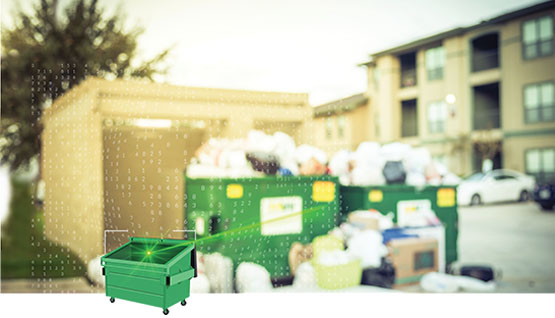Embracing the new: Trash of tomorrow
I keep hearing talk about the new normal. Like those two words actually belong side by side. Do they coexist? Absolutely. Do they describe our future? In my mind, you have to have one or the other; and I vote for new—change. We should reach for something better. Oftentimes, new can simply mean different; like a change in behavior. Yet how we get there is always by embracing the new.
It is exciting to see our industry shifting, changing and exploring the new. We look at our processes and try to find new ways to achieve the same result using tools instead of people.
Virtual reality (VR) apartment tours allow future residents to see their future home without the direct contact of leasing staff. We look at how we pay bills and ask if we can use technology to reduce paper and handing things to each other, thereby leaving our sanctum sanctorum. All of this involves identifying a challenge and solving it differently than we have in the past. I suppose the inference of the new normal is that we embrace the new and it becomes normal.
It is unsurprising that we have not approached managing trash as other aspects of our business. Historically, trash has been treated as a back-of-house issue and not as an area of resident engagement.
In the 1990s the first shift occurred when recycling became more prevalent and we needed residents to engage in activities around waste. Then in the 2000s we experienced another change with the adoption of package delivery, which made many goods more accessible. This increased our waste production to include more furniture, electronics, clothing and packaging materials.
Once it became more cost-effective for residents to replace an item than to repair it, trash became a challenge—not just of cost, but of functionality. Now we’re left to consider: How do we manage it? How do we engage residents to assist? We struggle with waste. Trash is hard.
And now—how does new normal apply to trash? Initially, we should look at why our waste programs are what they are and ask the important questions: “Who handles my program?” “Do I outsource, and if so, am I comfortable with their services for my community with our new normal?” “What do my residents experience and does my program make them feel taken care of?” “Where are my bins located and what kinds do I have?” “Do I have to provide recycling or composting and if so, how much?” “What are the ramifications for not complying with a waste requirement?”
My favorite question, which always surprises: “Is my waste program adaptive for the seasonality of my residents’ behaviors?” Then there is the new question: “How do I leverage technology to manage my trash?” You can utilize virtual reality for your tours, but you really cannot VR your trash program. Or can you?
Let’s plan for the future. The pandemic has many companies evaluating their workforce and whether workers can be just as productive remotely as they can be in an office. Many companies are realizing that a large percentage of their workforce doesn’t necessarily need to come into the office to be productive. This revelation and change will affect how many residents work from home and should be part of our new normal for trash and the resident experience with our community. How does this affect our trash programs? Our maintenance teams? Historically, waste is a labor-intensive function. Someone has to service the enclosures, pull the bins out for pickup, and physically manage the program.
As haulers get more sophisticated, our properties are being fined, along with receiving documentation of our indiscretions: “Here is a photo of your overflowing bin of trash, which we will now fine you for.” “Here is the contamination, which we are fining you for,” or “Here is the contamination, which is why we are refusing to service your property.”
Haulers work with technology, yet as an industry our greatest innovations around waste require additional workforce in our communities. When we fight technology with increased manpower—we are not winning.
Okay. So we understand the challenges. We see what haulers are doing, and we understand our current programs. Now is the time to ask the question, “What is our new normal?” What if there was technology that continuously monitored your program for you and advised you, your team or your vendor when and where there is something to address? There are sensors on many compactors today to inform users when those compactors are full and ready to service. What if you had this visibility into a dumpster? How could you manage or reduce your labor (even if outsourced) if you knew the seasonality of your residents’ behavior without physically inspecting those areas for issues? What if AI could advise of a full bin that needed to be rotated under a trash chute? What if AI could help resolve contamination before it’s serviced by the hauler? What if that same technology could deliver information to residents so they could modify their behavior? What if AI could help you comply with whatever rules and regulations you are faced with in your market?
The reality is that the technology is out there. It is not completely new, but maybe new to our industry. This brings us to our present moment. The questions we need to brainstorm are: “What will our trash programs look like in the new normal?” “How will we achieve savings and objectives?”
Mary Nitschke, Publisher
Historical perspective
- March 2024
- February 2023
- July 2022
- March 2022
- June 2021
- February 2021
- August 2020
- February 2020
- July 2019
- April 2019
- June 2018
- April 2018
- October 2017
- May 2017
- November 2016
- June 2016
- November 2015
- June 2015
- September 2014
- June 2014
- April 2014
- December 2013
- July 2013
- December 2012
- July 2012
- October 2011



